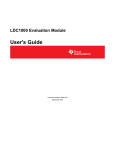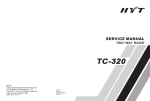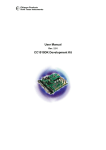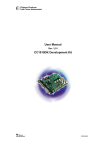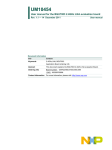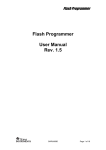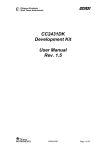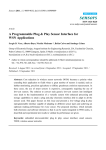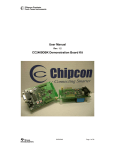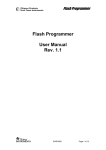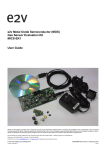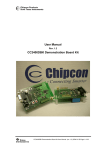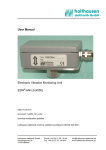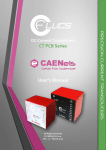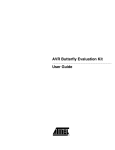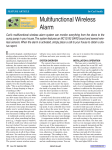Download SWRU125 - Texas Instruments
Transcript
CC2430DB Demonstration Board User Manual SWRU125 Page 1 Table of content 1 2 3 Introduction......................................................................................................................3 Definitions........................................................................................................................3 Kit content .......................................................................................................................3 3.1 Hardware.....................................................................................................................3 4 Getting started.................................................................................................................3 5 Hardware description CC2430DB....................................................................................4 5.1 Powering CC2430DB ..................................................................................................4 5.2 USB Interface..............................................................................................................5 5.3 User interface..............................................................................................................5 5.4 EEPROM.....................................................................................................................5 5.5 Accelerometer .............................................................................................................5 5.6 Potentiometer..............................................................................................................5 5.7 Light sensor.................................................................................................................6 5.8 I/O connectors.............................................................................................................6 5.9 Jumper settings...........................................................................................................7 5.9.1 P3 Jumpers ........................................................................................................7 5.9.2 P5 Jumpers ........................................................................................................8 5.10 Signal flow ..............................................................................................................9 6 Using CC2430DB for prototyping ..................................................................................10 6.1 Debugging using the USB interface ..........................................................................10 6.2 Debugging CC2430DB with the CC2430 debug connector .......................................10 6.3 Low power operation .................................................................................................11 6.4 Using the UART interface on the CC2430DB ............................................................13 7 Programming CC2430 with a HEX file...........................................................................14 8 Schematics....................................................................................................................14 9 Bill of Materials (BOM)...................................................................................................15 10 Document History ..........................................................................................................17 SWRU125 Page 2 1 Introduction This manual contains reference information for the CC2430 DB hardware. The following tools, which can be used with the kit, have their own user manual that can be downloaded from the TI website: - SmartRF® Studio - Chipcon general packet sniffer - IAR EW8051 C-compiler and C-Spy debugger (www.IAR.se) The CC2430DB demonstration board includes a number of functions and applications that allows quick testing of the RF interface and peripherals of the CC2430. It can for example be used for: • • • Evaluation of SmartRF®04 products. Measurement of current consumption. The kit is designed for low power operation, and with an ampere meter the current consumption can be measured for all operating modes. Prototype development. The CC2430DB includes a USB interface that can be used as emulator interface for the CC2430. Additionally, all I/O ports are available on pin connector on the board to allow easy access for external applications. 2 Definitions CC2430DB USB MCU Factory firmware SoC ICE CC2430 Demonstration Board; described in this user manual The Silicon Labs C8051F320 MCU used to provide a USB interface on the CC2430DB The firmware that is supplied programmed into the USB MCU from the factory. This firmware supports SmartRF® Studio operation. System on a Chip. A collective term used to refer to Chipcon ICs with on-chip MCU and RF transceiver In Circuit Emulator 3 Kit content 3.1 Hardware The CC2430DB kit contains the following: - 1 CC2430DB demonstration board - 1 USB cable - Quick start guide - This document 4 Getting started Make sure to install SmartRF® Studio before connecting the CC2430DB to a PC, as it installs the required hardware drivers on the PC. SmartRF® Studio can be downloaded from the TI web pages: http://focus.ti.com/docs/toolsw/folders/print/smartrftm-studio.html SWRU125 Page 3 5 Hardware description CC2430DB Joystick I/O connector A CC2430 Reset CC2430 debug LED Button S1 CC2430 DC jack (Reverse) USB connector PCB Antenna Battery clip (Reverse) Low current jumpers Power switch S3 USB MCU debug connector Pot. Low current jumpers I/O connector B Accelerometer Light sensor EEPROM USB MCU Figure 1: CC2430DB overview 5.1 Powering CC2430DB The CC2430DB can be powered in three different ways: • 2.5 mm DC jack connector. This connector is placed under the board. The centre pin is used for the positive voltage. A 4-10V DC power supply should be used. The onboard voltage regulator supplies 3.3V to the board. • USB power. If the CC2430DB is connected to a USB socket on a PC, it will draw power from the USB bus. The onboard voltage regulator supplies 3.3V to the board. • Battery power. The CC2430DB includes a battery clip for two AA type batteries If several power sources are connected, the CC2430DB will be powered from the supply that supplies the highest voltage. The USB MCU is only powered when USB or DC jack power is used. SWRU125 Page 4 Figure 2: Power switch setting The Power Switch S3 must be set according to what power source is used. If DC jack or USB power is applied, the switch should be set to the USB position. If the board is powered from batteries, the switch should be set to the BATT position as shown in Figure 2. When either DC power or batteries are used to power the board, the switch can be used as an on/off switch. When powering the CC2430DB from batteries, the CC2430 will work down to 1.8V. Please note that when using USB, the voltage range is limited to 3.0V – 3.6V. The CC2430DB has been designed for a temperature range of –40° C to +85° C. 5.2 USB Interface The USB interface is used to interface to a PC to run the In-Circuit Emulator in the IAR Embedded Workbench (IAR EW) and using SmartRF® Studio. The IAR EW can also be used to reprogram the CC2430DB (see the IAR EW manual for more details). Furthermore, it is also possible to reprogram the CC2430DB via the USB interface with the Chipcon programming software, or to use the board for the Chipcon packet sniffer. When connected to the USB port the CC2430DB is powered from the USB and no other voltage supplies are required. Please refer to the Chipcon Flash Programmer User Manual installed with SmartRF® Studio for a detailed description of how to reprogram the CC2430DB. 5.3 User interface The CC2430DB includes a joystick and a push button as user input devices, and two LEDs as user output devices. 5.4 EEPROM A 32Kbit EEPROM is included for non volatile storage of data that is frequently updated. The EEPROM has 1 Million guaranteed write cycles. 5.5 Accelerometer The accelerometer can be used to measure movements in 2 axes. It can also be used for tilt measurements by measuring the earth’s gravitation. The accelerometer has a 20 ms start-up time after power on. See the Analog Devices ADXL321 datasheet for details about the accelerometer. 5.6 Potentiometer The potentiometer controls the voltage on the analog input pin P0_7 of the CC2430. The voltage, and thus the potentiometer position, can be measured with the CC2430 A/D converter. SWRU125 Page 5 5.7 Light sensor A light dependent resistor (LDR) measures light level and gives an analog signal that is measured by the CC2430 A/D converter. The light sensor resistance ranges from 5KΩ (light) to 20MΩ (dark). 5.8 I/O connectors The I/O connectors bring out all the signals from CC2430. These connectors allow easy access to all CC2430 I/O pins. External circuitry can be connected to these connectors for prototyping. Pin 1 2 3 4 5 6 7 8 9 10 11 12 13 14 15 16 17 18 19 20 Function VDD VDD_SW_CONTROLLED1 P0_0/LDR RESET_N P0_1/BUTTON PUSH P1_7/SO/MISO/UART_RD P0_2/EE_SDA P1_6/SI/MOSI/UART_TD P0_3/EE_SCL P1_5/SCLK/RTS P2_1/DD P1_4/CSN/SS/CTS P2_2/DC P2_0/JOY PUSH P0_6/JOY P1_2/VDD_SW_CTRL P0_7/POT P1_1/LED2 P1_0/LED1 GND Table 1: I/O connector A (P6) pin-out Pin 1 2 3 4 5 6 Function P1_3/GPIO DC_JACK_PWR P0_4/ACC_X VDD P0_5/ACC_Y GND Table 2: I/O connector B (P7) pin-out 1 VDD_SW_CONTROLLED is controlled by the signal named VDD_SW_CTRL SWRU125 Page 6 5.9 Jumper settings P3, pin 5-6: Accelerometer self test P5, pin 1-2: Connects DD (Debug Data) P3, pin 3-4: SW controlled power P5, pin 3-4: Connects DC (Debug Clock) P3, pin 1-2: Replace with ampere meter to measure current consumption of CC2430 P5, pin 5-6: Connects RESET_N Figure 3: CC2430DB Jumper settings Header P3 Pin 1-2 P3 3-4 P3 5-6 P4 P4 7-9 9-10 P5 1-2 P5 3-4 P5 5-6 Description Replace with ampere meter to measure current consumption of CC2430 SW controlled power. Can be removed when performing current measurement to reduce leakage current Accelerometer self test. Mount to perform accelerometer self test function. See also section 5.9.1. Manual reset of USB MCU Mount during power on to force USB MCU into boot loader Connects DD (Debug Data) between USB MCU and CC2430. Should be removed when connecting ICE to P8 “2430deb“ connector Connects DC (Debug Clock) between USB MCU and CC2430. Should be removed when connecting ICE to P8 “2430deb” connector Connects RESET_N signal between USB MCU and CC2430. Can be removed when performing current measurement to reduce leakage current Default setting Mounted Mounted Not mounted Not mounted Not mounted Mounted Mounted Mounted Table 3: Jumper settings summary 5.9.1 P3 Jumpers The jumper between pin 1-2 on P3 can be replaced with an ampere meter to measure current consumption of CC2430. The jumper must be mounted for normal operation. SWRU125 Page 7 The jumper between pin 3-4 can be removed when performing current measurement to reduce leakage current of the peripheral devices connected to the CC2430. The jumper must be mounted for normal operation The jumper between pin 5-6 can be mounted to perform accelerometer self test function. By mounting this jumper, a voltage is applied to the accelerometer outputs. See the Analog Devices ADXL321 datasheet for details about the accelerometer self test. The jumper must be removed for normal operation. Figure 4: Default P3 jumper settings 5.9.2 P5 Jumpers All jumpers on header P5 must be mounted for normal operation. The jumper between pin 1-2 on P5 connects DD (Debug Data) between USB MCU and CC2430. The jumper between pin 3-4 on P5 connects DC (Debug Clock) between USB MCU and CC2430DB. When the CC2430DB is used with emulator connected to the USB port, both the DD and DC jumpers must be mounted. They should only be removed if an external emulator is used. Chapter 6.2 gives instructions on how to connect the external emulator to the CC2430DB. The jumper between pin 5-6 on P5 connects RESET_N signal between USB MCU and CC2430. The jumper can be removed when performing current measurement to reduce leakage current for the circuits connected to the RESET pin. The jumper must be mounted for normal operation. Figure 5: P5 default jumper settings SWRU125 Page 8 5.10 Signal flow The signal lines from the I/O connectors and the CC2430 run via 0Ω resistors to the various peripherals on the CC2430DB. The peripherals can be disconnected from the CC2430 signal pins by removing the 0Ω resistors. Please refer to Table 6 for a list of what resistors correspond to which signals. 0 ohm Figure 6: CC2430DB Signal flow SWRU125 Page 9 6 Using CC2430DB for prototyping The CC2430DB can be used for prototyping by programming the CC2430 with custom applications. All I/O ports on the CC2430 are available on pin row header at the edge of the board, and the USB interface can be used as In Circuit Emulator (ICE) interface allowing real time in circuit emulation of the CC2430. Table 6 on page 13 shows what pins on the MCU are used for various functions. P6 and P7 pin-row connectors can be used to connect the CC2430DB to other PCB or prototyping boards. See page 6 for the pin-out of these connectors. 0Ω resistors are included to isolate the CC2430 from the external components on the CC2430DB. By removing these resistors, signals can be accessed on the pin headers. Refer to section 5.10 and Table 6 for information about which pin corresponds to which resistor. 6.1 Debugging using the USB interface The most common way to use the CC2430DB for development is to use the USB interface to control the CC2430 on-chip In-Circuit Emulator. The USB interface supplies power to the board, so there is no need for additional DC power or batteries. The USB interface can also be used to program the CC2430 in circuit using the Chipcon programming software. 6.2 Debugging CC2430DB with the CC2430 debug connector The CC2430DB can be used with the Chipcon packet sniffer or other applications that require USB interface for communication with PC and debugging with an emulator simultaneously. In these cases the SoC debug connector can be used for connecting the ICE. The SmartRF04EB can be used as emulator interface with a cable from P14 “SoC debug/flash” on SmartRF04EB to P8 “2430deb” on CC2430DB. See Figure 7 below. The jumpers between pin 1-2, 3-4 and 4-5 on header P5 must be removed. CC2430DB must be powered from battery, USB or DC jack when debugged from SmartRF04EB. Figure 7: CC2430 Debug Connector SWRU125 Page 10 6.3 Low power operation CC2430DB is designed for low power operation when running from batteries. Only the CC2430 is powered in this mode, the USB MCU is not powered. The voltage to the peripheral functions connected to the CC2430 is controlled by an I/O pin P1.2 (VDD_SW_CTRL) on the CC2430. Table 4 lists the current consumption for each of the peripherals. To obtain minimum current consumption with the CC2430DB, the VDD_SW_CTRL (P1.2) output must be configured as output. Figure 8: Voltage supply distribution Table 4 below shows the current consumption for all modules and operation modes with 3.3V supply voltage SWRU125 Page 11 Active mode (mA) Typical Max 7,2 27 1 3 0,49 0,33 0,001 0.015 24 9mA 54mA Device CC2430 EEPROM Accelerometer Potentiometer Light sensor LEDs Total Power down mode (µA) 32KHz Sleep 1µA 0.3µA 0 0 0 0 0 1µA Table 4: Current consumption summary To accurately measure the current consumption of the chip the jumpers listed in Table 5 should be removed. Header Pin P3 1-2 P3 3-4 P5 5-6 Description Replace with ampere meter to measure current consumption of CC2430 SW controlled power. Can be removed when performing current measurement to reduce leakage current Connects RESET_N signal between USB MCU and CC2430. Can be removed when performing current measurement to reduce leakage current Low power setting Mounted, or connect ampere meter Not mounted Not mounted Table 5: Jumper setting for low power measurements In order to achieve lowest possible current consumption, the I/O ports of the CC2430 should be configured as listed in Power down state in Table 6 below. 2430 pin Name Schematic Name 11 P0_0 P0_0/LDR 12 P0_1 P0_1/BUTTON PUSH Light dependent resistor analog input Push button interrupt active low 13 P0_2 P0_2/EE_SDA EEPROM SDA 14 P0_3 P0_3/EE_SCL EEPROM SCL 15 P0_4 P0_4/ACC_X Accelerometer x-axis 16 P0_5 P0_5/ACC_Y Accelerometer y-axis 17 P0_6 P0_6/JOY Joystick analog signal 18 P0_7 P0_7/POT Potentiometer analog input 9 P1_0 P1_0/LED1 Green LED 8 P1_1 P1_1/LED2 Red LED Description Active state2 IN ANALOG IN PULLUP OUT HIGH OUT HIGH IN ANALOG IN ANALOG IN ANALOG IN ANALOG OUT HIGH OUT HIGH Power down state OUT LOW 0Ω ohm resistor R506 IN OUT LOW OUT LOW OUT LOW OUT LOW OUT LOW OUT LOW OUT HIGH OUT HIGH 2 R505 R504 R507 R508 R416 R430 Active state means that Software controlled VDD is on, this should only be enabled when required by an I/O module SWRU125 Page 12 6 P1_2 P1_2/VDD_SW _CTRL 5 P1_3 P1_3/GPIO 4 P1_4 3 P1.5 2 P1_6 1 P1_7 48 P2_0 P2_0/Joy_push 46 P2_1 45 10 Voltage control for I/O modules Free I/O for controlling external signal OUT HIGH OUT LOW OUT LOW OUT LOW OUT LOW OUT LOW OUT LOW OUT LOW OUT LOW OUT LOW OUT LOW OUT LOW Joystick push interrupt active high IN IN P2_1/DD Debug Data IN P2_2 P2_2/DC Debug Clock IN RESET RESET_N Reset P1_4/CSn/SS/ CTS P1_5/SCLK/RT S P1_6/SI/MOSI/ UART_TD P1_7/SO/MISO /UART_RD R305 R308 R306 R307 Jumper P5 Jumper P5 Jumper P5 Table 6: Pinout CC2430 The joystick output is coded as an analog voltage. This has been done in order to save the number of pins required on the MCU to interface with the joystick. The push function of the joystick is connected to a digital input pin. 6.4 Using the UART interface on the CC2430DB The CC2430 UART interface port is accessible on the header connectors as 3.3V signals. An RS232 driver circuit is required to connect the UART interface on CC2430DB to a serial port on a PC. The RS232 port on a SmartRF04EB can be connected to the CC2430DB to allow applications to interface to a PC serial port. Table 7 shows the connection between the CC2430DB and the SmartRF04EB. Both the P8 (10-pin) connector and the P6 (20-pin) connector on the CC2430DB can be used, but only one of them should be connected at the same time. Signal Name RD TD RTS CTS GND SmartRF04EB P10 9 11 13 15 20 CC2430DB P8, ”2430deb” 10 8 6 5 1 CC2430DB P6, ”I/O A” 6 8 10 12 20 Table 7: CC2430ZDK to SmartRF04EB serial port connections A jumper must be placed between pin 7 and pin 9 on the USB MCU debug connector P301 on the SmartRF04EB board. This will ensure that the Silabs USB controller does not force any pins to erroneous levels. To use the serial port on CC2430DB USART1 must be used on alternative location 2 in the CC2430. Please see the CC2430 datasheet for instructions how to select serial port and location. Using the SmartRF04EB will only work if the Silabs USB controller on the CC2430DB is powered, i.e. the CC2430DB must be powered from a USB or DC jack. SWRU125 Page 13 7 Programming CC2430 with a HEX file The CC2430 can be programmed from the USB interface using the Chipcon programming software. Figure 9 shows the flash programming interface. For additional information regarding Chipcon Flash Programmer please refer to Chipcon Flash Programmer User Manual. Figure 9: Chipcon Flash programmer software 8 Schematics See the CC2430DB Reference Design for CC2430DB schematics. The CC2430DB reference design can be downloaded from the product page for CC2430DB on TI’s websites. SWRU125 Page 14 9 Bill of Materials (BOM) Ref. Part name Pcs/ unit B1-2 1XAA_1_5V 2 Description Mounting clip for one AA battery cell U500 24AA32A/SN 1 4 KB I2C EEPROM U401 AD8544 1 Rail-to-rail quad opamp 18 g peak X,Y accelerometer U501 ADXL321 1 D100-101 BAT254 2 Q300 BC846 1 U300 C8051F320 1 U1 CC2430 C_1U_0402_ X5R_K_6P3 1 C71 C207;C281;C300; C400;C471;C500; C503 1 Diode, Si, Schottkey BJT, Si, NPN, smallsignal Silicon Labs 8051 USB Microcontroller Single-chip transceiver and microcontroller Capacitor 1uF, 0402, X5R,10%, 6.3V Manufacturer Part number Keystone Microchip Analog Devices Analog Devices 24AA32A/SN Philips BAT254 Philips BC846B Silicon Labs C8051F320 Chipcon Murata CC2430 GRM155R60 J105KE19D murata GRM21BR61A106K Murata GRM21 AD8544AR ADXL321 C251;C271;C381 C_100N_0402 _X5R_K_10 C_100P_0402 _NP0_J_50 C_10N_0402 _X7R_K_25 C_10U_0805 _X5R_L_25 C_15P_0402 _NP0_J_50 C_220N_0402 _X5R_K_10 C_220N_0603 _X7R_K_50 C_33P_0402 _NP0_J_50 C_2U2_0603 _X5R_K_10 C_33N_0402 _X7R_K_25 C_4U7_0805 _X5R_K_6 C_5P6_0402 _NP0_J_50 C_68P_0402 _NP0_J_50 P2 DC_JACK_2.5 1 U101 EM6353_1_8V 1 Capacitor, 100n, 0402, X5R, 10%, 10V Capacitor, 100p, 0402, NP0, 5% 50V Capacitor, 10n, 0402, X7R, 10%, 25V Capacitor, 10u, 0805, XR5, 15% 25V Capacitor, 15p, 0402, NP0, 5%, 50V Capacitor, 220n, 0402, X5R, 10%, 10V Capacitor, 220n, 0603, X7R, 10%, 50V Capacitor, 33p, 0402, NP0, 5%, 50V Capacitor, 2u2, 0603, X5R, 10%, 10V Capacitor, 33n, 0402, X7R, 10%, 25V Capacitor, 4U7, 0802, X5R, 10%, 6.3V Capacitor, 5p6, 0402, NP0, 5%, 50V Capacitor, 68p, 0402, NP0, 5% 50V DC jack, 2.5mm center pin brown-out detector, 200ms delay, SOT23-3 "beta" pinout, 1.8V D1 LED_CL150GCD 1 LED, green, 1206 Citizen CL150GCD D2 LED_CL150URCD 1 LP2985-3.3V 1 Citizen National Semiconductor CL150URCD U100 LED, red, 1206 Voltage regulator, low noise, 3.3 V Inductor, 1n8, 0402, Monolithic type, +/-0.3 nH Murata LQG15-series Inductor, 22n, 0402, 5% Inductor, 6n8, 0402, Monolithic type, +/-5% Silonix CdS photoconductive cell 5 kOhm (light) to 20 M Ohm (dark) 2x10 pinrow, 2.54mm pitch, through-hole Murata LQG15-series Murata LQG15-series Silonix NSL-19M51 AMP 5-0826632-0 C401 C101;C351; C501-502 C102 C431;C441 C231;C411;C421 C241 C191;C211 C103 C104 C100 C341 7 1 4 1 2 3 1 2 1 1 1 1 3 L341 L_1N8_0402_S 1 L331 L_22N_0402_J 1 L321 L_6N8_0402_J 1 RP1 NSL_19M51 1 P6 PINROW_2X10 1 SWRU125 EM Microelectronic EM6353 LP2985AIM5-3.3 Page 15 P3;P5;P7 PINROW_2X3 3 P4;P8 PINROW_2X5 2 S1-2 PUSH_BUTTON 2 RT1 R303-304; R311-312 R100;R305;R306307; R308;R416;R430; R504-508 R_0-10K_TRIM 1 R_0603 4 R_0_0603 12 2x3 pinrow, 2.54mm pitch, through-hole 2x5 pinrow, 2.54mm pitch, through-hole Momentary pushbutton, SMD 10k trimming pot with knob Resistor, general, 0603; Do not mount AMP 0-0826632-3 AMP 0-0826632-5 Alps BI Technologies SKHUAF 72PTR10K R405;R410-412 R_100K_0402_F 4 Resistor, 0 ohms, 0603 Resistor, 100k, 0402, 1% R413-415 R_10K_0402_F 3 Resistor, 10k, 0402, 1% Koa R300-302 R403-404;R407; R501 R_1K0_0402_J 3 Koa R_200K_0402_F 4 R409 R_220K_0402_F 1 Resistor, 1k, 0402, 5% Resistor, 200k, 0402, 1% Resistor, 220k, 0402, 1% Resistor, 270 ohm, 0402, 1% Resistor, 2k2, 0402, 2% Resistor, 2 ohm, 0402, 1% Resistor, 330k, 0402, 1% Resistor, 43K, 0402, 1% Resistor, 470k, 0402, 1% Resistor, 4.7k, 0402, 2% Resistor, 56K, 0402, 1% Koa MOS-FET, p-channel Double switch, ALPS SSSS222700 USB B-style PCBmount socket Crystal, 32.000MHz,NX3225DA, 10/15ppm, 16 pF ! Temp range -30 - +85 deg C ! Crystal, 32.768 kHz, 12.5pF, 20/50 ppm,SMD package 4-directional switch with a centre push Siliconix SI9424DY ALPS SSSS222700 AMP 787780-1 NDK NX3225DA Epson MC-306 Alps skrhab_e010 R400;R440-441 R_270_0402_F 3 R502-503 R_2K2_0402_G 2 R241 R_2_0402_F 1 R406 R101;R261;R310; R401;R420 R_330K_0402_F 1 R_43K_0402_F 5 R402 R_470K_0402_F 1 R102;R309;R509 R_4K7_0402_G 3 R221 R_56K_0402_F 1 Q100 SI9424DY 1 S3 SWITCH_6PIN 1 P1 USB_B 1 X1 X_32.000/ 10/15/30/16 1 X2 X_32.768/ 20/50/40/12 1 U400 skrhab_e010 1 SWRU125 Koa Koa Koa Koa Koa Koa Koa Koa Koa Koa Koa Page 16 10 Document History Revision 1.0 Date 2007-04-16 Initial release SWRU125 Description/Changes Page 17 IMPORTANT NOTICE Texas Instruments Incorporated and its subsidiaries (TI) reserve the right to make corrections, modifications, enhancements, improvements, and other changes to its products and services at any time and to discontinue any product or service without notice. Customers should obtain the latest relevant information before placing orders and should verify that such information is current and complete. All products are sold subject to TI’s terms and conditions of sale supplied at the time of order acknowledgment. TI warrants performance of its hardware products to the specifications applicable at the time of sale in accordance with TI’s standard warranty. Testing and other quality control techniques are used to the extent TI deems necessary to support this warranty. Except where mandated by government requirements, testing of all parameters of each product is not necessarily performed. TI assumes no liability for applications assistance or customer product design. Customers are responsible for their products and applications using TI components. To minimize the risks associated with customer products and applications, customers should provide adequate design and operating safeguards. TI does not warrant or represent that any license, either express or implied, is granted under any TI patent right, copyright, mask work right, or other TI intellectual property right relating to any combination, machine, or process in which TI products or services are used. Information published by TI regarding third-party products or services does not constitute a license from TI to use such products or services or a warranty or endorsement thereof. Use of such information may require a license from a third party under the patents or other intellectual property of the third party, or a license from TI under the patents or other intellectual property of TI. Reproduction of information in TI data books or data sheets is permissible only if reproduction is without alteration and is accompanied by all associated warranties, conditions, limitations, and notices. Reproduction of this information with alteration is an unfair and deceptive business practice. TI is not responsible or liable for such altered documentation. Resale of TI products or services with statements different from or beyond the parameters stated by TI for that product or service voids all express and any implied warranties for the associated TI product or service and is an unfair and deceptive business practice. TI is not responsible or liable for any such statements. TI products are not authorized for use in safety-critical applications (such as life support) where a failure of the TI product would reasonably be expected to cause severe personal injury or death, unless officers of the parties have executed an agreement specifically governing such use. Buyers represent that they have all necessary expertise in the safety and regulatory ramifications of their applications, and acknowledge and agree that they are solely responsible for all legal, regulatory and safety-related requirements concerning their products and any use of TI products in such safety-critical applications, notwithstanding any applications-related information or support that may be provided by TI. Further, Buyers must fully indemnify TI and its representatives against any damages arising out of the use of TI products in such safety-critical applications. TI products are neither designed nor intended for use in military/aerospace applications or environments unless the TI products are specifically designated by TI as military-grade or "enhanced plastic." Only products designated by TI as military-grade meet military specifications. Buyers acknowledge and agree that any such use of TI products which TI has not designated as military-grade is solely at the Buyer's risk, and that they are solely responsible for compliance with all legal and regulatory requirements in connection with such use. TI products are neither designed nor intended for use in automotive applications or environments unless the specific TI products are designated by TI as compliant with ISO/TS 16949 requirements. Buyers acknowledge and agree that, if they use any non-designated products in automotive applications, TI will not be responsible for any failure to meet such requirements. Following are URLs where you can obtain information on other Texas Instruments products and application solutions: Products Applications Amplifiers amplifier.ti.com Audio www.ti.com/audio Data Converters dataconverter.ti.com Automotive www.ti.com/automotive DSP dsp.ti.com Broadband www.ti.com/broadband Interface interface.ti.com Digital Control www.ti.com/digitalcontrol Logic logic.ti.com Military www.ti.com/military Power Mgmt power.ti.com Optical Networking www.ti.com/opticalnetwork Microcontrollers microcontroller.ti.com Security www.ti.com/security Low Power Wireless www.ti.com/lpw Telephony www.ti.com/telephony Video & Imaging www.ti.com/video Wireless www.ti.com/wireless Mailing Address: Texas Instruments, Post Office Box 655303, Dallas, Texas 75265 Copyright © 2007, Texas Instruments Incorporated


















